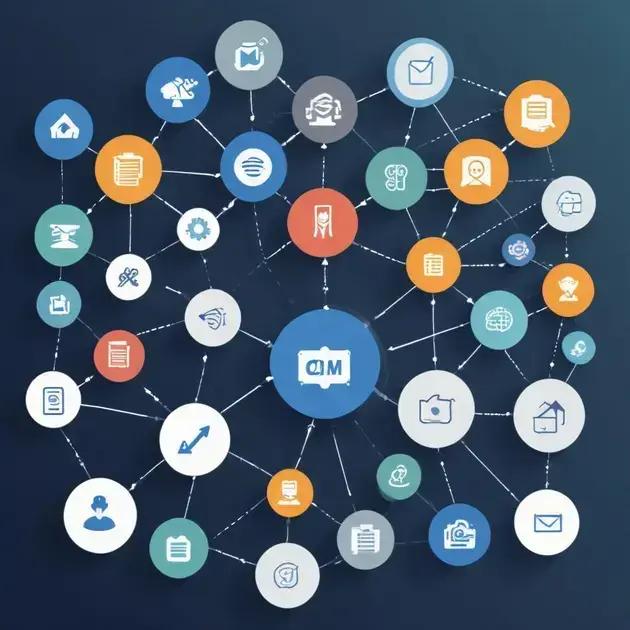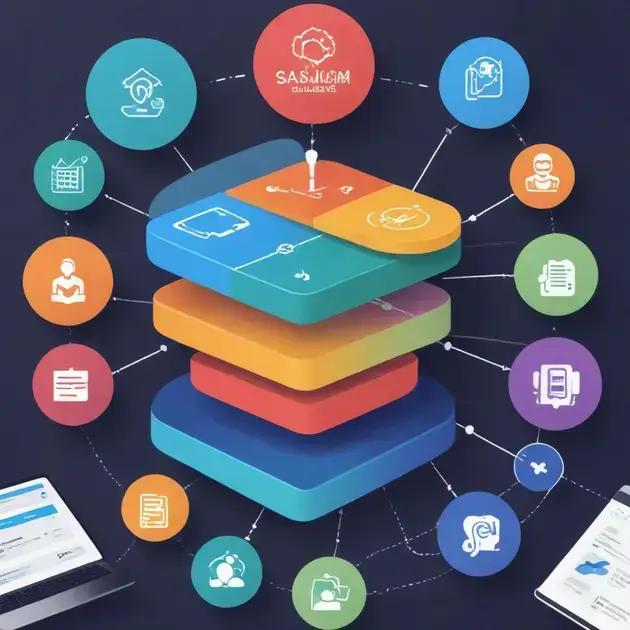A well-integrated sales tech stack enhances efficiency and boosts revenue by streamlining processes and improving team collaboration. By choosing the right tools and maximizing ROI, businesses can significantly improve their sales performance and achieve sustainable growth.
When we talk about a sales tech stack, we’re diving into the vital toolkit that empowers sales teams to achieve remarkable results. In today’s fast-paced world, having the right combination of tools is more crucial than ever. This article will take you through the essentials of understanding, selecting, and maximizing your sales tech stack, ensuring you’re equipped to drive business growth and streamline operations.
Understanding Sales Tech Stack
Understanding the sales tech stack is essential for businesses aiming to improve their sales processes. A sales tech stack refers to the collection of tools and software that sales teams use to enhance productivity and drive revenue. These tools facilitate everything from lead generation to customer relationship management.
What Is Included in a Sales Tech Stack?
A comprehensive sales tech stack typically includes several key components:
- Customer Relationship Management (CRM) Software: This is the backbone of any sales tech stack. It helps track interactions with customers and facilitates communication.
- Sales Automation Tools: These tools automate repetitive tasks such as sending emails or scheduling meetings, allowing salespeople to focus on closing deals.
- Data Analytics Tools: Sales analytics provide insights into team performance and customer behavior, enabling informed decision-making.
- Lead Generation Tools: Tools dedicated to finding and qualifying prospects, helping to build a solid pipeline.
- Communication Tools: Platforms for internal and external communication, such as email, messaging, and video conferencing applications.
Why is a Sales Tech Stack Important?
Implementing a sales tech stack is vital for improving efficiency and effectiveness in sales operations. By utilizing these tools, teams can better manage their time, prioritize leads, and ultimately close more deals. Moreover, an appropriate tech stack allows for seamless integration, providing valuable insights and fostering collaboration among team members.
Key Components of an Effective Sales Tech Stack

To build an effective sales tech stack, it is crucial to identify and integrate essential components that work together to streamline sales processes. Here are the key components that should be included:
1. Customer Relationship Management (CRM)
A CRM system is vital for managing customer relationships and tracking interactions. It provides insights into customer data, preferences, and buying patterns, helping sales teams to tailor their approaches.
2. Sales Enablement Tools
These tools support sales teams by providing access to resources, content, and training necessary for successful sales activities. They help in equipping representatives with the knowledge and tools needed to engage effectively with prospects.
3. Email Automation Software
Email automation tools help to streamline communication with leads and customers. These tools enable scheduling and sending personalized follow-ups, improving engagement rates and reducing manual effort.
4. Analytics and Reporting Tools
Analytics tools provide insights into sales performance. They help track metrics such as conversion rates, deal size, and sales cycle length, enabling teams to make data-driven decisions to improve sales strategies.
5. Collaboration and Communication Platforms
Effective collaboration and communication tools are essential for teams, especially in a remote working environment. Platforms like Slack or Microsoft Teams enhance communication, making it easier for sales teams to collaborate on deals and share updates.
How to Choose the Right Sales Tools
Choosing the right sales tools is critical for creating an effective sales tech stack. Here are essential steps to guide you in making informed decisions:
1. Assess Your Sales Needs
Start by evaluating your sales team’s specific needs and pain points. Understand what tasks are most time-consuming and where improvements can be made. This assessment will help identify the types of tools that can enhance productivity.
2. Research Available Tools
Once you have a clear idea of your needs, research the various sales tools available. Look for tools that have good reviews, offer demos, and fit well with your budget. Consider both established names and newer tools that may offer innovative solutions.
3. Evaluate Integration Capabilities
Ensure that the tools you choose can easily integrate with your existing systems, such as your CRM, marketing software, and accounting tools. This integration is vital for creating a seamless workflow and avoiding data silos.
4. Test and Get Feedback
Before committing to any tool, consider running a pilot program. Allow team members to test the tools and provide feedback. This hands-on experience can reveal potential issues and help ensure that the tool meets your needs.
5. Review Pricing and ROI
Finally, evaluate the pricing structure of each tool in relation to the return on investment (ROI) it offers. Look for tools that provide flexible pricing plans and demonstrate how they can help increase sales and reduce costs over time.
Integrating Your Sales Tech Stack

Integrating your sales tech stack is essential for maximizing efficiency and enhancing communication within your sales team. A well-integrated tech stack allows for seamless data flow and collaboration. Here are key steps to ensure successful integration:
1. Identify Integration Needs
Begin by identifying the systems and tools that need to work together within your sales tech stack. This might include your CRM, email marketing tools, and analytics platforms. Determine which data points need to be shared between these systems for smooth operation.
2. Choose Compatible Tools
Ensure that the tools you select for your sales tech stack can integrate easily with one another. Many software solutions offer built-in integrations with other popular applications, which can save time and technical headaches. Always check the integration capabilities before making a purchase.
3. Utilize API Connections
For tools that do not offer native integrations, consider using API (Application Programming Interface) connections. APIs allow different systems to communicate and share data. If you don’t have technical expertise in-house, hiring a developer can help set up these connections efficiently.
4. Train Your Team
Once your tools are integrated, it is crucial to train your sales team on how to use them effectively. This training should cover new workflows and any changes in processes due to the integration. Staff should feel comfortable navigating the new system to maximize productivity.
5. Monitor and Optimize
After integration, continuously monitor the effectiveness of your sales tech stack. Gather feedback from your team about any challenges they face. Use this information to optimize processes and make adjustments to improve communication and data flow.
Maximizing ROI from Sales Tech Stack
Maximizing the return on investment (ROI) from your sales tech stack requires a strategic approach. Here are some effective strategies to help ensure you get the most value from your sales tools:
1. Measure Performance Metrics
Establish clear performance metrics to evaluate the effectiveness of each tool in your sales tech stack. Track sales growth, lead conversion rates, and customer retention to understand how well the tools are performing. Regularly review these metrics to see where improvements can be made.
2. Provide Training and Support
Invest in training for your sales team to ensure they are utilizing the tools effectively. Proper training helps team members understand the full capabilities of the tools, which can significantly improve productivity and performance.
3. Encourage Collaboration
Foster a culture of collaboration among your sales team by using communication tools integrated into your sales tech stack. Improved communication can lead to better teamwork and more effective sharing of insights and strategies, ultimately enhancing sales outcomes.
4. Optimize Tool Usage
Regularly analyze how each tool is being used and identify any features that may go unused. Optimize the usage of each tool by customizing settings and workflows to better fit your sales process.
5. Gather Feedback for Continuous Improvement
Solicit feedback from your sales team on the tools they find most helpful and any challenges they face. Use this information to make informed decisions about upgrades, replacements, or additional tools that may enhance the overall effectiveness of your sales tech stack.
Maximizing Your Sales Tech Stack for Success
In conclusion, having an effective sales tech stack is vital for driving business growth. By understanding its components, carefully choosing the right tools, and integrating them seamlessly, you set the stage for increased sales efficiency.
Moreover, optimizing your tools and measuring their performance ensures that you make the most of your investment. Don’t forget the importance of training your team and encouraging collaboration to enhance overall productivity.
As you harness the power of your sales tech stack, be ready to adapt and evolve. Continuous improvement will help your business stay ahead in the competitive market and achieve remarkable results.
FAQ – Frequently Asked Questions about Sales Tech Stack
What is a sales tech stack?
A sales tech stack is a collection of tools and software that sales teams use to manage customer relationships, automate tasks, and analyze performance.
Why is integrating sales tools important?
Integrating sales tools is crucial because it ensures seamless data flow, improves communication within the team, and enhances overall efficiency.
How can I maximize the ROI from my sales tech stack?
To maximize ROI, measure performance metrics, provide training, encourage collaboration, and continuously gather feedback to optimize tool usage.
What are the key components of an effective sales tech stack?
Key components include CRM software, sales enablement tools, email automation, analytics tools, and communication platforms.
How do I choose the right sales tools for my business?
Assess your specific sales needs, research available tools, ensure compatibility, test them through pilot programs, and evaluate pricing vs. ROI.
What role does team training play in using sales tools effectively?
Training is essential to ensure that your team understands how to use the tools effectively, which can significantly enhance productivity and sales outcomes.




